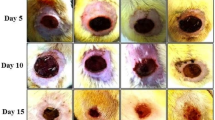Abstract
Burn injury, one of the most common diseases in primary care, is also a major cause of death and disability. The aim of this study was to evaluate the effect of cuttlebone (CB) extract in thermal burn wounds in rats and to compare its effects with those of silver sulfadiazine (SSD), the most widely used burn treatment. Burn injury was produced in rats by immersion of the shaved dorsal area to hot water. CB or SSD was applied topically after burn injury. Histological analysis, CBC counts and malonialdehyde (MDA) activities were evaluated 1, 4, 7, and 14 days post-treatment. CB and SSD significantly increased re-epithelialization in burn wounds and decreased WBC levels after 14 days of treatment. These drugs also reduced expression of pro-inflammatory cytokines, such as tumor necrosis factor (TNF)-α and interleukin (IL)-6. By FT-IR, we characterized chitin the main component of CB. Taken together, these results suggest the wound healing effects of CB and its therapeutic value in the treatment of burn injury.
Similar content being viewed by others
References
Morgan ED, Bledsoe SC, Barker J. Ambulatory management of burns. Am. Fam. Physician 62: 2015–2026 (2000)
Zhang YM, Fang YD, Wang YC, Wang SL, Lei ZY, Liu XW, Mao TC, Fan DL. Role of serum amyloid P in skin graft survival and wound healing in burned patients receiving skin grafts. Clin. Chim. Acta 412: 227–229 (2011)
Kahn SA, Beers RJ, Lentz CW. Use of acellular dermal replacement in reconstruction of nonhealing lower extremity wounds. J. Burn Care Res. 32: 124–128 (2011)
Demirtas Y, Yagmur C, Soylemez F, Ozturk N, Demir A. Management of split-thickness skin graft donor site: A prospective clinical trial for comparison of five different dressing materials. Burns 36: 999–1005 (2010)
Vloemans AF, Soesman AM, Suijker M, Kreis RW, Middelkoop E. A randomised clinical trial comparing a hydrocolloid-derived dressing and glycerol preserved allograft skin in the management of partial thickness. Burns 29: 702–710 (2003)
Hemmila MR, Mattar A, Taddonio MA, Arbabi S, Hamouda T, Ward PA, Wang SC, Baker JR Jr. Topical nanoemulsion therapy reduces bacterial wound infection and inflammation after burn injury. Surgery 148: 499–509 (2010)
Steen M. Review of the use of povidone-iodine (PVP-I) in the treatment of burns. Postgrad. Med. J. 69: S84–S92 (1993)
Ward RS, Saffle JR. Topical agents in burn and wound care. Phys. Ther. 75: 526–538 (1995)
Berger MM, Binnert C, Chiolero RL, Taylor W, Raffoul W, Cayeux MC, Benathan M, Shenkin A, Tappy L. Trace element supplementation after major burns increases burned skin trace element concentrations and modulates local protein metabolism but not whole-body substrate metabolism. Am. J. Clin. Nutr. 85: 1301–1306 (2007)
Shanmugam A, Mahalakshmi TS, Barwin VA. Antimicrobial activity of polysaccharides isolated from the cuttlebone of Sepia aculeate and Sepia brevimana: An approach to selected antimicrobial activity for human pathogenic microorganisms. J. Fish. Aquat. Sci. 3: 268–274 (2008)
García-Enriquez S, Guadarrama HE, Reyes-González I, Mendizábal E, Jasso-Gastinel CF, García-Enriquez B, Rembao-Bojórquez D, Pane-Pianese C. Mechanical performance and in vivo tests of an acrylic bone cement filled with bioactive sepia officinalis cuttlebone. J. Biomat. Sci.-Polym. E. 21: 113–125 (2010)
Hackman RH. Studies on chitin I. Enzymic degradation of chitin and chitin esters. Aust. J. Biol. Sci. 7: 168–178 (1954)
Hackman RH, Goldberg M. Studies on chitin VI. The nature of α- and β-chitin. Aust. J. Biol. Sci. 18: 935–946 (1965)
Meyer TN, Silva AL, Vieira EC, Alves AC. Heat shock response reduces mortality after severe experimental burns. Burns 26: 233–238 (2000)
Dokumcu Z, Ergun O, Celik HA, Aydemir S, Sezak M, Ozok G, Celik A. Clostridial collagenase aggravates the systemic inflammatory response in rats with partial-thickness burns. Burns 34: 935–941 (2008)
Hiramatsu M, Izawa Y, Hagihara M, Nishigaki I, Yagi K. Serum Lipid peroxide levels of patients suffering from thermal injury. Burns Incl. Therm. Inj. 11: 111–116 (1942)
Cetinkale O, Belce A, Konukoglu D, Senyuva C, Gumustas MK, Tas T. Evaluation of lipid peroxidation and total antioxidant status in plasma of rats following thermal injury. Burns 23: 114–116 (1997)
Schwacha MG. Macrophages and post-burn immune dysfunction. Burns 29: 1–14 (2003)
Fang CW, Yao YM, Zhai HX, Yu Y, Wu Y, Lu LR, Sheng ZY, Sheng CY. Tissue lipopolysaccharide-binding protein expression in rats after thermal injury: Potential role of TNF-α. Burns 30: 225–231 (2004)
Shigemasa Y, Matsuura H, Sashiwa H, Saimoto H. Evaluation of different absorbance ratios from infrared spectroscopy for analyzing the degree of deacetylation in chitin. Int. J. Biol. Macromol. 18: 237–242 (1996)
Brigham PA, McLoughlin E. Burn incidence and medical care use in the United States: Estimates, trends, and data sources. J. Burn Care Rehabil. 17: 95–107 (1996)
Atiyeh BS, Costagliola M, Hayek SN, Dibo SA. Effect of silver on burn wound infection control and healing: Review of the literature. Burns 33: 139–148 (2007)
Singer AJ, Clark RA. Cutaneous wound healing. New Engl. J. Med. 341: 738–746 (1999)
Lee CG. Chitin, chitinases, and chitinase-like proteins in allergic inflammation and tissue remodeling. Yonsei Med. J. 50: 22–30 (2009)
Valentine R, Athanasiadis T, Moratti S, Hanton L, Robinson S, Wormald PJ. The efficacy of a novel chitosan gel on hemostasis and wound healing after endoscopic sinus surgery. Am. J. Rhinol. Allergy 24: 70–75 (2010)
Raghow R. The role of extracellular matrix in post inflammatory wound healing and fibrosis. FASEB J. 8: 823–831 (1994)
Author information
Authors and Affiliations
Corresponding author
Rights and permissions
About this article
Cite this article
Jang, J.K., Lee, O.S., Kang, T.J. et al. Wound healing effect of cuttlebone extract in burn injury of rat. Food Sci Biotechnol 22 (Suppl 1), 99–105 (2013). https://doi.org/10.1007/s10068-013-0054-4
Received:
Revised:
Accepted:
Published:
Issue Date:
DOI: https://doi.org/10.1007/s10068-013-0054-4




